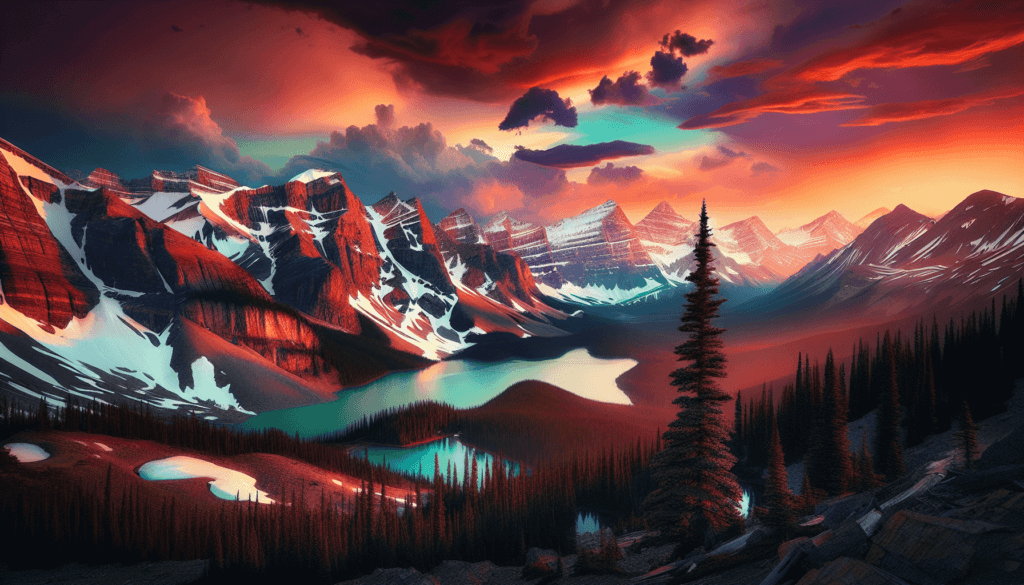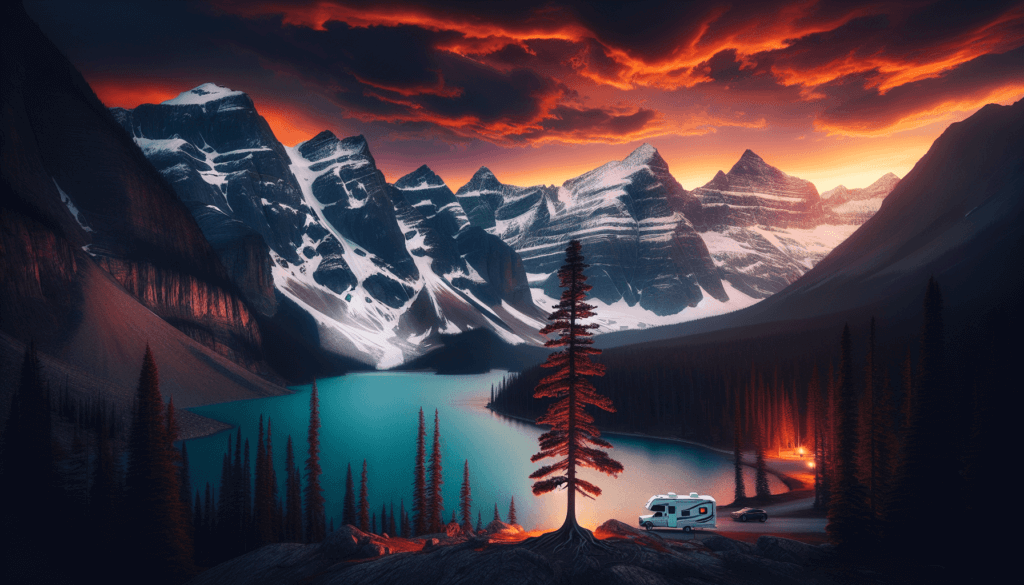If you’re an avid nature lover seeking a breathtaking adventure, look no further than RV camping in the Rocky Mountains. Imagine waking up to the gentle sound of flowing streams, surrounded by majestic peaks and vibrant wildflowers. This article will take you on a journey through the awe-inspiring beauty of the Rocky Mountains, providing insights on the best camping spots, activities to indulge in, and the abundant wildlife that calls this alpine wonderland home. Get ready to escape the hustle and bustle of everyday life as you immerse yourself in the tranquility and splendor of this natural paradise.

1. Best Time to Go
The Rocky Mountains offer breathtaking beauty all year round, but certain times of the year may be more favorable for camping. In terms of weather conditions, the summer months from June to August are considered the best time to visit. During this period, temperatures are generally comfortable, ranging from the 70s to low 80s Fahrenheit, making it ideal for outdoor activities and camping. However, it’s worth noting that the weather can be unpredictable, and sudden rain showers and thunderstorms may occur. But don’t let that dampen your spirits – just be prepared with rain gear and a positive attitude!
In terms of crowd levels, it’s important to consider the peak season from July to August when planning your trip. This is when the Rocky Mountains attract a large number of tourists, so popular campgrounds and hiking trails can get quite crowded. If you prefer a quieter and more serene experience, consider visiting in the shoulder seasons of spring (April to June) or fall (September to October). During these times, the crowd levels are lower, and you can enjoy the beauty of the Rocky Mountains with more solitude and tranquility.
2. Choosing a Campground
When it comes to choosing a campground in the Rocky Mountains, there are several factors to consider: location, facilities, and reservations.
Location
The Rocky Mountains span several states, including Colorado, Wyoming, Montana, and Idaho, offering a wide range of camping options. Think about what kind of experience you’re looking for. If you want to be close to popular hiking trails and scenic drives, consider campgrounds near national parks such as Rocky Mountain National Park or Glacier National Park. On the other hand, if you prefer a more secluded and off-the-beaten-path experience, look for campgrounds in remote areas or on the outskirts of smaller towns.
Facilities
Facilities vary from campground to campground, so it’s important to check what amenities are available before making a decision. Most campgrounds in the Rocky Mountains offer basic facilities such as restrooms, fire pits, and picnic tables. However, if you prefer a more comfortable camping experience, look for campgrounds with additional amenities like showers, electrical hookups, and dump stations for RVs. Some campgrounds even have camp stores where you can purchase essentials or rent equipment.
Reservations
Given the popularity of RV camping in the Rocky Mountains, it’s advisable to make reservations in advance, especially during the peak season. Many campgrounds allow online reservations, making it convenient to secure your spot. Keep in mind that some campgrounds operate on a first-come, first-served basis, so arriving early in the day is crucial if you don’t have a reservation. Planning ahead ensures you have a guaranteed place to stay and allows you to enjoy your trip without the stress of finding available campsites.
3. Essential Gear
To make the most of your RV camping adventure in the Rocky Mountains, it’s important to have the right gear. Here are some essential items you’ll need:
RV Essentials
If you’re traveling in an RV, ensure you have all the necessary equipment to make your experience comfortable. This includes items such as leveling blocks, water hoses, sewer hoses, and electrical adapters. It’s also important to have a reliable GPS or map to navigate the mountainous terrain and find your way to campsites and attractions.
Outdoor Gear
Outdoor activities are a big part of the Rocky Mountain camping experience, so having the right outdoor gear is essential. Don’t forget to pack sturdy hiking boots or shoes, a backpack for day hikes, and appropriate clothing for changing weather conditions. Other useful items to consider include camping chairs, a portable grill, a cooler for food storage, and insect repellent. Being prepared with the right gear will ensure a comfortable and enjoyable time exploring the alpine beauty of the Rocky Mountains.
4. Hiking Trails
The Rocky Mountains boast a plethora of hiking trails, catering to all experience levels. Whether you’re a seasoned hiker or a beginner, there’s a trail for everyone. When choosing a hiking trail, consider the difficulty level and the scenic views it offers.
Difficulty Levels
Hiking trails in the Rocky Mountains vary in difficulty, ranging from easy walks to challenging climbs. If you’re a beginner or prefer a more leisurely hike, look for trails labeled as easy or moderate. These trails often have well-marked paths and gentle inclines, making them suitable for all ages and fitness levels. For more experienced hikers seeking a challenge, there are strenuous trails that involve steep ascents, rocky terrain, and higher elevations. Always assess your fitness level and select a trail that matches your abilities.
Scenic Routes
One of the highlights of hiking in the Rocky Mountains is the breathtaking scenery. Many trails offer stunning views of snow-capped peaks, alpine lakes, and lush forests. If you’re drawn to panoramic landscapes, consider hiking trails that lead to lookout points, mountain summits, or waterfall viewpoints. These routes often provide opportunities for fantastic photo opportunities and a chance to immerse yourself in the awe-inspiring beauty of the Rocky Mountains.

5. Wildlife Spotting
The Rocky Mountains are home to a diverse range of wildlife species. From majestic elk and bison to elusive bears and mountain lions, encountering wildlife can be a thrilling experience. However, it’s important to remember that these animals are wild and should be respected from a safe distance. Here are some common animals you may encounter and safety tips to keep in mind:
Common Animals
Some of the common wildlife you may spot in the Rocky Mountains include elk, mule deer, bighorn sheep, black bears, and moose. These animals inhabit the forests, meadows, and mountainsides of the region. Keep an eye out for them while hiking or driving through the park, but remember to admire them from a safe distance and avoid approaching them or feeding them.
Safety Tips
When encountering wildlife, it’s important to prioritize safety for both you and the animals. Keep a safe distance of at least 100 yards or more and use binoculars or a telephoto lens for closer views. Do not attempt to approach or feed the animals, as it can disrupt their natural behavior and pose risks to both you and the animals. Keep food and other scented items securely stored to avoid attracting wildlife to your campsite. By practicing responsible wildlife viewing, you can enjoy the beauty of these creatures while preserving their natural habitat.
6. Fishing Opportunities
If you’re a fishing enthusiast, RV camping in the Rocky Mountains offers ample opportunities to cast your line and reel in some impressive catches. Here’s what you need to know about fishing in the area:
Available Fish Species
The rivers, lakes, and streams of the Rocky Mountains are teeming with various fish species. Common fish you can catch include trout (rainbow, brown, and brook), salmon, bass, and pike. These fish thrive in the cold, clear waters of the mountainous region, offering anglers a chance to experience the thrill of catching their dinner surrounded by stunning natural beauty.
Licensing and Regulations
Before you embark on your fishing adventure, make sure to familiarize yourself with the local fishing regulations and obtain the necessary fishing licenses. Each state within the Rocky Mountains has its own set of rules and requirements, which may include catch limits, size restrictions, and specific fishing seasons. Responsible fishing practices, such as catch and release, are encouraged to preserve the fragile ecosystem of the mountain lakes and rivers.

7. Scenic Drives
If you prefer to explore the Rocky Mountains at a more leisurely pace, scenic drives are a fantastic way to soak in the unparalleled beauty of the alpine landscapes. Here are some recommended routes and must-see landmarks along the way:
Recommended Routes
- Trail Ridge Road (Colorado): This iconic road in Rocky Mountain National Park takes you through breathtaking alpine meadows and offers sweeping views of the surrounding mountain ranges. Be prepared for high elevation and potentially snowy conditions, even in the summer months.
- Going-to-the-Sun Road (Montana): Located in Glacier National Park, this scenic drive spans over 50 miles and takes you through diverse landscapes, including glacial lakes, towering peaks, and lush valleys. The road is known for its narrow passages and dramatic drop-offs, so drive with caution and take advantage of the numerous pull-offs for photo opportunities.
- Beartooth Highway (Wyoming and Montana): This exhilarating drive winds through the Beartooth Mountains, treating you to jaw-dropping views of snow-covered peaks, pristine lakes, and alpine tundra. The highway is renowned for its switchbacks and steep drop-offs, so it’s not for the faint of heart. However, the awe-inspiring vistas make it well worth the journey.
Must-see Landmarks
- Maroon Bells (Colorado): Known as the most photographed peaks in North America, the Maroon Bells offer a picture-perfect postcard view of the Rockies. Located near Aspen, these twin peaks are surrounded by crystal-clear lakes, vibrant wildflowers, and golden aspen groves in the fall.
- Old Faithful (Wyoming): As the star attraction of Yellowstone National Park, Old Faithful is a must-see landmark for its famous geyser eruptions. Witness the awe-inspiring spectacle as the geyser shoots steaming hot water high into the air, surrounded by the park’s unique geothermal features.
- Grand Teton National Park (Wyoming): With its towering peaks and pristine lakes, Grand Teton National Park is a paradise for nature enthusiasts. Take a drive along the Teton Park Road and marvel at the majestic mountain range reflected in the crystal-clear waters of Jenny Lake.
8. Photography Tips
The Rocky Mountains offer a photographer’s dream, with its majestic peaks, vibrant wildflowers, and diverse wildlife. To capture the beauty of the alpine landscapes, consider these photography tips:
Capturing the Mountains
- Use a wide-angle lens to capture the grandeur of the Rocky Mountains. This lens allows you to include more of the expansive scenery in your shots.
- Experiment with different perspectives by incorporating foreground elements such as wildflowers, rivers, or rocky outcrops. This adds depth and visual interest to your photographs.
- Take advantage of early morning or late afternoon lighting for softer, more dramatic shots. The Golden Hour, when the sun is low on the horizon, casts a warm glow on the mountains, creating a magical atmosphere.
- Don’t forget to include people in your photos for scale and to add a sense of adventure. Capture the joy of hiking, fishing, or simply enjoying the immense beauty of the Rocky Mountains.
Wildlife Photography
- For wildlife photography, a telephoto lens is essential to capture animals from a safe distance.
- Be patient and observant. Spend time studying an animal’s behavior and movement patterns to anticipate the perfect shot.
- Avoid using flash as it may startle or disturb the animals. Natural light is often the best choice for capturing the beauty and authenticity of wildlife.
- Consider shooting in burst mode to capture a series of rapidly changing movements, expressions, or flight patterns. This increases your chances of getting that perfect action shot.

9. Local Attractions
In addition to the natural wonders of the Rocky Mountains, there are also several local attractions worth exploring during your RV camping adventure. Here are some national parks and historical sites to include in your itinerary:
National Parks
- Rocky Mountain National Park (Colorado): Famous for its sweeping mountain vistas, alpine lakes, and diverse wildlife, Rocky Mountain National Park offers endless opportunities for outdoor exploration. Hike to the summit of Longs Peak, drive along the Trail Ridge Road, or simply enjoy a picnic amidst the beauty of the park.
- Glacier National Park (Montana): Known as the Crown of the Continent, Glacier National Park features stunning glaciers, pristine lakes, and rugged mountains. Take a scenic hike along the Highline Trail, explore the Going-to-the-Sun Road, or enjoy a boat ride on the crystal-clear waters of Lake McDonald.
Historical Sites
- Mount Rushmore National Memorial (South Dakota): This iconic monument showcases the faces of four U.S. presidents carved into the granite mountain. Learn about the history and significance of this national treasure, and marvel at the craftsmanship and artistry behind the sculpted presidents.
- Mesa Verde National Park (Colorado): Discover the ancient civilizations of the Pueblo people at Mesa Verde National Park. Explore the well-preserved cliff dwellings and learn about the fascinating history and culture of these early inhabitants.
10. Safety Considerations
While the Rocky Mountains offer unparalleled beauty and thrilling adventures, it’s important to prioritize safety during your RV camping trip. Here are a few safety considerations to keep in mind:
Altitude Sickness
The high elevations of the Rocky Mountains can cause altitude sickness, especially for those who are not accustomed to higher altitudes. Symptoms may include dizziness, nausea, headache, and shortness of breath. To minimize the risk of altitude sickness, stay hydrated, avoid alcohol and strenuous activities upon arrival, and gradually acclimate to the higher elevations.
Emergency Services
Before embarking on your RV camping adventure, familiarize yourself with the nearest emergency services and medical facilities in the area. It’s important to be prepared for any unforeseen circumstances. Carry a well-stocked first aid kit, have a means of communication in case of emergencies, and inform someone of your travel plans and expected return date.
RV camping in the Rocky Mountains is an unforgettable experience that allows you to immerse yourself in the awe-inspiring beauty of the alpine landscapes. By considering the best time to go, choosing the right campground, packing essential gear, exploring hiking trails, spotting wildlife, fishing in pristine waters, embarking on scenic drives, capturing stunning photographs, visiting local attractions, and prioritizing safety, you’re sure to create lasting memories and discover the true essence of the Rocky Mountains. So grab your RV, pack your sense of adventure, and get ready for an incredible journey through alpine beauty!



